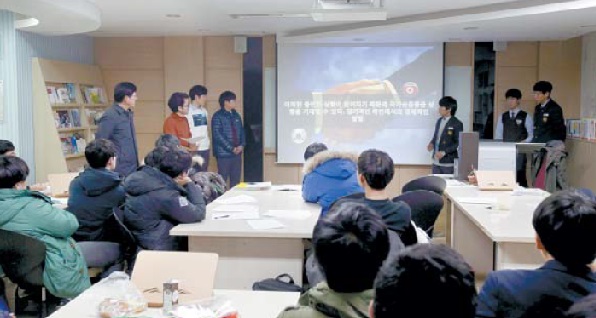Combined education classes picking up steam

Dongbuk High School students discuss the unification of South and North Korea in a combined education class on Nov. 26. This academic approach combines different subjects and will be included in the curriculum in high schools nationwide starting 2018. [OH JONG-TAEK]
“I think artificial intelligence will be able to substitute human jobs in the future,” said one of the students, who was participating in an after-school debate class on Nov. 26.
“Self-developing artificial intelligence is highly likely to replace human beings.”
As he finished, his classmate rebutted, arguing that there are roles only humans can do.
In total, 32 high school freshmen presented their thoughts during the last combined reading class of the year.
The discussion topics covered various subjects, and more philosophical statements like, “Why Humans Live” fueled the debate. Some of the eight teachers present also contributed their opinions occasionally.
“We’ve had a combined education for a year now, and since then, the students’ abilities to question and answer themselves have improved,” economics teacher Kwon Young-boo said.
Combined education, which integrates different subjects in classes like the one offered at Dongbuk High School, will be adopted at high schools nationwide from 2018 under a new revision to the curriculum that was approved in September.
Under the revision, two new subjects, combined social studies and combined science, will be compulsory for students entering high school in 2018.
Dongbuk High School, however, is already above the curve, having already embraced combined education in 2005.
The idea to offer an after-school course surfaced when some of the teachers there had different thoughts after reading the same book. So they set about applying a debate-style approach to students.
Since then, the teachers have gathered every Friday to prepare the next week’s combined education class. First, they choose a topic, and then each comes up with ideas about how to relate the new information to the subjects they teach.
One of the topics centered on the unification of South and North Korea, for which the educators used to explain unification’s economic influence as well as the situation in the demilitarized zone (DMZ). The class also read literature related to unification.
Each group of students then selected a presentation topic, with one teacher assigned to serve as a mentor.
“We were taught before that the unification of the two Koreas is a national challenge, so as part of the combined education class, we tried to find out the actual benefits of unification,” said 16-year-old Bang Young-min.
Son Seung-woo, also 16, added, “Even though I wasn’t interested in unification, I learned about the different organisms and plant life present in the demilitarized zone after attending the class, where I made up a plan for an ecological park in the DMZ.”
The after-school class is unrelated to current classwork or exams. However, students are still required to prepare a presentation for the combined education class in the following week.
Koo Sang-mo, 16, said the class taught him the value of combined education, and some students majoring in natural sciences even expressed interest in liberal arts subjects, and vice versa.
But combined education also seeks to change high school assessments. The Ministry of Education said it will focus more on evaluating students based on the value of their work rather than written examinations. Participation and creativity will largely determine a student’s grades.
“Combined education can only succeed when teachers teaching different subjects gather together frequently to think about it more,” said Park Byeong-gi, a professor at Korea National University of Education.
“The baccalaureat, an academic exam French students must take to qualify for a university, includes a combination of many subjects. Therefore, students should have the creativity necessary to integrate different subjects to answer questions.”
BY NAM YOON-SEO [koo.yurim@joongang.co.kr]










with the Korea JoongAng Daily
To write comments, please log in to one of the accounts.
Standards Board Policy (0/250자)